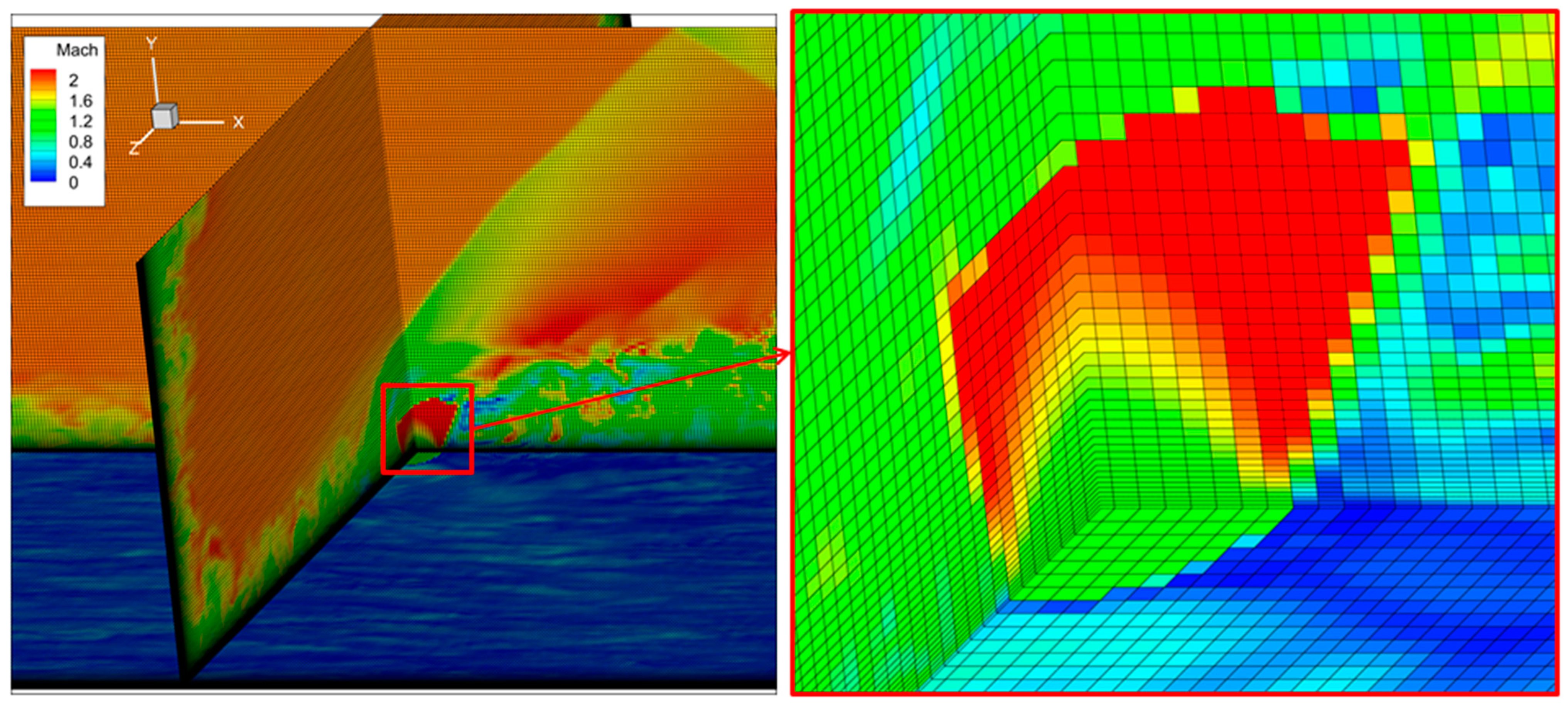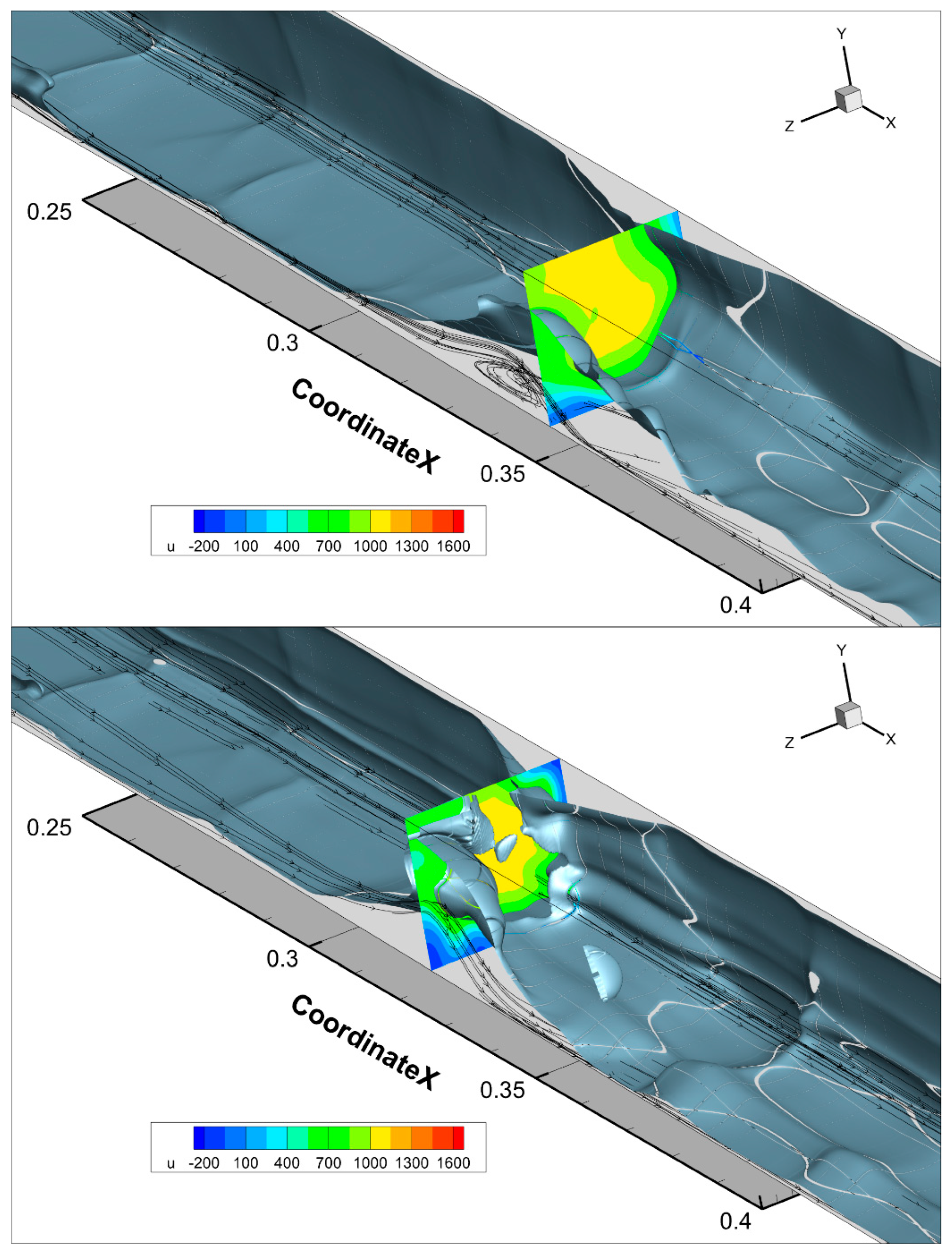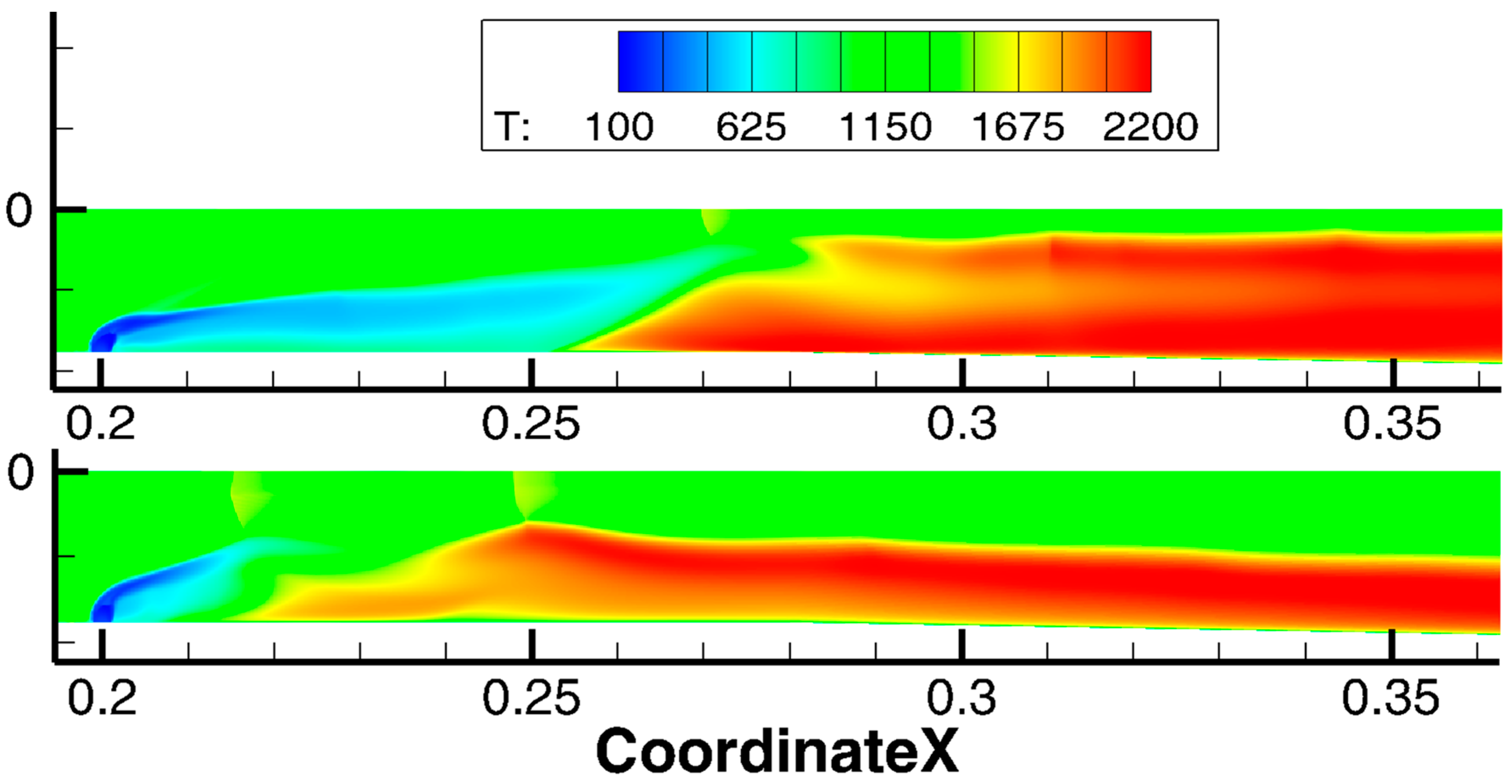Improved Delayed Detached Eddy Simulation of Combustion of Hydrogen Jets in a High-Speed Confined Hot Air Cross Flow II: New Results
Abstract
:1. Introduction
2. Mathematical Model and Numerical Method
3. Estimations of the Experimental Model Wall Heating
4. Analysis of the Optical Windows Influence
5. Analysis of the Secondary Flows Influence
6. Analysis of the Influence of Roughness Height
7. Analysis of the Influence of the Resolved Turbulence at the Inlet
8. Results of the New IDDES Simulation
9. Discussion and Conclusions
- It was established that chemical kinetics and optical windows have a minor effect on the pressure distribution along the duct. However, they affect the shape of the separation zones.
- Roughness and the wall temperature, on the contrary, have a major effect on the pressure distribution along the duct and a minor influence on the shape of the separation zones.
- A significant influence on the pressure distribution along the duct and the shape of the separation zones is exerted by the nonlinear model of turbulent stresses in the case of the RANS approach and the generation of synthetic turbulence in the case of the IDDES approach.
- It was demonstrated that within the RANS framework, at a given wall temperature of 716 K, satisfactory agreement with the experimental pressure distribution can be achieved by increasing the roughness height from 65 to 85 μm if the secondary flows in the duct corners are reproduced in the simulation. In this case, the flow contains a large central separation and partial chocking, which does not contradict the Schlieren photographs taken in the experiment. However, no oscillations in this gas-dynamic structure were observed.
- The first reason for excessive temperature and pressure values in the flow may be the initial field and the first 0.002 s of the simulation, during which hs = 80 μm was maintained. To check this, an IDDES simulation was run from the field obtained in the RANS simulation with hs = 65 μm. Figure 18 shows the simulation at the time moment 0.00204 s; the flow pattern is in good agreement with the experiment. However, the pressure distribution on the wall contains a second peak at x = 0.3 m, which is not present in the experiment. At the same time, the pressure is still overestimated in the area (0.3;0.6) m along the X axis (Figure 19). During further modeling, the gas-dynamic structure oscillated once along the X axis and reached the same state as the previous eddy-resolving simulation.
- The second reason may be an incorrect description of the separation before the injection, as evidenced by the difference in the pressure distribution. In all simulations, the pressure level before injection is lower than in the experiment; see Figure 10 and Figure 19. In RANS simulations, this disadvantage is probably compensated by an increase in the roughness height. The question of modeling this separation using an eddy-resolving approach and its effect on the combustion process requires a separate study.
- The third reason is a possibly excessive level of turbulence kinetic energy in the boundary layer upstream of the injection. The synthetic turbulence generator converts the turbulence energy received in RANS into resolved and subgrid energies while maintaining the total value. However, the initial value was obtained as a result of a relatively coarse simulation of the heater and may turn out to be too high. This may not affect RANS simulations but may be significant in eddy-resolving simulations. A decrease in the turbulence energy at the duct entrance will lead to a decrease in the subgrid energy. Therefore, the eddy viscosity and the quality of fuel mixed with oxidizer will decrease. This issue also needs to be researched separately.
- The fourth reason is modeling only the lower half of the duct. According to experimental data kindly provided by Dr. A. Vincent-Randonnier, the selected mode is statistically symmetric (4098 snapshots were taken, and the correlation coefficient between the leading edges of the top and bottom flames ≈ 0.95). However, the instantaneous positions of the top and bottom flames can differ by up to 6 mm in the streamwise direction during the first 0.015 s of the simulation. In eddy-resolving simulations, this may turn out to be significant. This can be investigated by simulating the full model, which will require at least twice as many computational resources.
Author Contributions
Funding
Data Availability Statement
Acknowledgments
Conflicts of Interest
References
- Zhiyin, Y. Large-eddy simulation: Past, present and the future. Chin. J. Aeronaut. 2015, 28, 11–24. [Google Scholar] [CrossRef]
- Piomelli, U. Large eddy simulations in 2030 and beyond. Philos. Trans. R. Soc. A 2014, 372, 2022. [Google Scholar] [CrossRef] [PubMed]
- Tkatchenko, I.; Kornev, N.; Jahnke, S.; Steffen, G.; Hassel, E. Performances of LES and RANS models for simulation of complex flows in a coaxial jet mixer. Flow Turbul. Combust. 2007, 78, 111–127. [Google Scholar] [CrossRef]
- Bogey, C.; Bailly, C. Computation of a high Reynolds number jet and its radiated noise using large eddy simulation based on explicit filtering. Comput. Fluids 2006, 35, 1344–1358. [Google Scholar] [CrossRef]
- Bres, G.A.; Lele, S.K. Modelling of jet noise: A perspective from large-eddy simulations. Philos. Trans. R. Soc. A 2019, 377, 2159. [Google Scholar] [CrossRef]
- Gaitonde, D.V. Progress in shock wave/boundary layer interactions. Prog. Aerosp. Sci. 2015, 72, 80–99. [Google Scholar] [CrossRef]
- Oefelein, J.C. Large eddy simulation of turbulent combustion processes in propulsion and power systems. Prog. Aerosp. Sci. 2006, 42, 2–37. [Google Scholar] [CrossRef]
- Spalart, P.R. Detached-eddy simulation. Annu. Rev. Fluid Mech. 2009, 41, 181–202. [Google Scholar] [CrossRef]
- Menter, F.; Hüppe, A.; Matyushenko, A.; Kolmogorov, D. An overview of hybrid RANS-LES models ddeveloped for industrial CFD. Appl. Sci. 2021, 11, 2459. [Google Scholar] [CrossRef]
- Oran, E.S.; Boris, J.P. Numerical Simulation of Reactive Flow, 2nd ed.; Cambridge University Press: Cambridge, UK, 2001; p. 540. Available online: https://citeseerx.ist.psu.edu/document?repid=rep1&type=pdf&doi=5e66cd1269fd730eb764ba71d60ddab94b558805 (accessed on 25 October 2023).
- Poinsot, T.; Veynante, D. Theoretical and Numerical Combustion; RT Edwards, Inc., 2005; p. 545. Available online: https://books.google.ru/books?hl=ru&lr=&id=cqFDkeVABYoC&oi=fnd&pg=PR11&dq=poinsot+combustion&ots=LftXMSQVex&sig=u42NxkhRjF_5LL8OPFDBgm-lv_s&redir_esc=y#v=onepage&q=poinsot%20combustion&f=false (accessed on 25 October 2023).
- Westbrook, C.K.; Mizobuchi, Y.; Poinsot, T.J.; Smith, P.J.; Warnatz, J. Computational combustion. Proc. Combust. Inst. 2005, 30, 125–157. [Google Scholar] [CrossRef]
- Poludnenko, A.Y.; Oran, E.S. The interaction of high-speed turbulence with flames: Global properties and internal flame structure. Combust. Flame 2010, 157, 995–1011. [Google Scholar] [CrossRef]
- Gatski, T.B. Second-moment and scalar flux representations in engineering and geophysical flows. Fluid Dyn. Res. 2009, 41, 12202. [Google Scholar] [CrossRef]
- Agostinelli, P.W.; Laera, D.; Boxx, I.; Gicquel, L.; Poinsot, T. Impact of wall heat transfer in Large Eddy Simulation of flame dynamics in a swirled combustion chamber. Combust. Flame 2021, 234, 111728. [Google Scholar] [CrossRef]
- Marusic, I.; McKeon, B.J.; Monkewitz, P.A.; Nagib, H.M.; Smits, A.J.; Sreenivasan, K.R. Wall-bounded turbulent flows at high Reynolds numbers: Recent advances and key issues. Phys. Fluids 2010, 22, 6. [Google Scholar] [CrossRef]
- Petranović, Z.; Edelbauer, W.; Vujanović, M.; Duić, N. Modelling of spray and combustion processes by using the Eulerian multiphase approach and detailed chemical kinetics. Fuel 2017, 191, 25–35. [Google Scholar] [CrossRef]
- Sun, X.; Liu, H.; Duan, X.; Guo, H.; Li, Y.; Qiao, J.; Liu, Q.; Liu, J. Effect of hydrogen enrichment on the flame propagation, emissions formation and energy balance of the natural gas spark ignition engine. Fuel 2022, 307, 121843. [Google Scholar] [CrossRef]
- Duan, X.; Xu, L.; Xu, L.; Jiang, P.; Gan, T.; Liu, H.; Ye, S.; Sun, Z. Performance analysis and comparison of the spark ignition engine fuelled with industrial by-product hydrogen and gasoline. J. Clean. Prod. 2023, 424, 138899. [Google Scholar] [CrossRef]
- Bakhne, S.; Troshin, A.; Sabelnikov, V.; Vlasenko, V. Improved delayed detached eddy simulation of combustion of hydrogen jets in a high-speed confined hot air cross flow. Energies 2023, 16, 1736. [Google Scholar] [CrossRef]
- Vincent-Randonnier, A.; Moule, Y.; Ferrier, M. Combustion of hydrogen in hot air flows within LAPCAT-II dual mode ramjet combustor at Onera-LAERTE facility-Experimental and numerical investigation. AIAA Pap. 2014, 2014–2932. [Google Scholar] [CrossRef]
- Balland, S.; Vincent-Randonnier, A. Numerical study of hydrogen/air combustion with CEDRE code on LAERTE dual mode ramjet combustion experiment. AIAA 2015, 2015–3629. [Google Scholar] [CrossRef]
- Vincent-Randonnier, A.; Sabelnikov, V.; Ristori, A.; Zettervall, N.; Fureby, C. An experimental and computational study of hydrogen–air combustion in the LAPCAT II supersonic combustor. Proc. Comb. Inst. 2019, 37, 3703–3711. [Google Scholar] [CrossRef]
- Pelletier, G.; Ferrier, M.; Vincent-Randonnier, A.; Sabelnikov, V.; Mura, A. Wall roughness effects on combustion development in confined supersonic flow. J. Propuls. Power 2021, 37, 151–166. [Google Scholar] [CrossRef]
- Sabelnikov, V.A.; Troshin, A.I.; Bakhne, S.; Molev, S.S.; Vlasenko, V.V. Poisk opredeljajushhih fizicheskih faktorov v validacionnyh raschetah jeksperimental’noj modeli ONERA LAPCAT II s uchetom sherohovatosti stenok kanala. (Search for determining physical factors in variational simulations of the experimental model ONERA LAPCAT II, taking into account the roughness of the duct walls.). Goren. I Vzryv (Combust. Explos.) 2021, 14, 55–67. (In Russian) [Google Scholar] [CrossRef]
- Reynolds, O. On the dynamical theory of incompressible viscous fluids and the determination of the criterion. Proc. R. Soc. Lond. 1894, 56, 40–45. [Google Scholar]
- Bruce, P.J.K.; Burton, D.M.F.; Titchener, N.A.; Babinsky, H. Corner effect and separation in transonic channel flows. J. Fluid Mech. 1997, 679, 247–262. [Google Scholar] [CrossRef]
- Bruce, P.J.K.; Babinsky, H.; Tartinville, B.; Hirsch, C. Corner effect and asymmetry in transonic channel flows. AIAA J. 2011, 49, 2382–2392. [Google Scholar] [CrossRef]
- Boychev, K. Shock Wave-Boundary-Layer Interactions in High-Speed Intakes. Ph.D. Thesis, University of Glasgow, Glasgow, Scotland, 2021. Available online: https://theses.gla.ac.uk/82577/ (accessed on 8 February 2023).
- Sabnis, K. Supersonic Corner Flows in Rectangular Ducts. Ph.D. Thesis, University of Cambridge, Cambridge, UK, 2020. [Google Scholar] [CrossRef]
- Spalart, P.R. Strategies for turbulence modeling and simulations. Int. J. Heat Fluid Flow 2000, 21, 252–263. [Google Scholar] [CrossRef]
- Mani, M.; Babcock, D.; Winkler, C.; Spalart, P.R. Predictions of a supersonic turbulent flow in a square duct. In Proceedings of the 51st AIAA Aerospace Sciences Meeting, Dallas, TX, USA, 7–10 January 2013. [Google Scholar] [CrossRef]
- Shur, M.L.; Spalart, P.R.; Strelets, M.K.; Travin, A.K. Synthetic Turbulence Generators for RANS-LES Interfaces in Zonal Simulations of Aerodynamic and Aeroacoustic Problems. Flow Turbul. Combust 2014, 93, 63–92. [Google Scholar] [CrossRef]
- Liu, W. Analysis of factors determining numerical solution in the calculation of flow with combustion using the ONERA experimental model. Thermophys. Aeromech. 2023, 30, 507–523. [Google Scholar] [CrossRef]
- Fureby, C. Large eddy simulations of the LAPCAT-II and the SSFE combustor configurations. AIAA SciTech Forum 2020, 2020-1109. [Google Scholar] [CrossRef]
- Volino, R.J.; Devenport, W.J.; Piomelli, U. Questions on the effects of roughness and its analysis in non-equilibrium flows. J. Turb. 2022, 23, 454–466. [Google Scholar] [CrossRef]
- Aupoix, B. Roughness corrections for the k-w SST model: Status and proposals. J. Fluids Eng. 2015, 137, 21202. [Google Scholar] [CrossRef]
- Latin, R.M.; Bowersox, R.D. Flow Properties of a Supersonic Turbulent Boundary Layer with Wall Roughness. AIAA J. 2000, 38, 10. [Google Scholar] [CrossRef]
- Schlichting, H. Experimental Investigation of the Problem of Surface Roughness; Technical Memorandums National Advisory Committee for Aeronautics: Washington, DC, USA, 1937. [Google Scholar]
- Troshin, A.I.; Molev, S.S.; Vlasenko, V.V.; Mikhailov, S.V.; Bakhne, S.; Matyash, S.V. Modelirovanie turbulentnih tecenii na osnove podhoda IDDES s pomosciu programmi zFlare (Simulation of turbulent flows based on the IDDES approach using the zFlare solver). Vici. Meh. Splosh. sred (Comput. Contin. Mech.) 2023, 16, 203–218. [Google Scholar] [CrossRef]
- Bosnyakov, S.; Kursakov, I.; Lysenkov, A.; Matyash, S.; Mikhailov, S.; Vlasenko, V.; Quest, J. Computational tools for supporting the testing of civil aircraft configurations in wind tunnels. Progr. Aerosp. Sci. 2008, 44, 67–120. [Google Scholar] [CrossRef]
- Menter, F.R.; Kuntz, M.; Langtry, R. Ten years of industrial experience with the SST turbulence model. Turbul. Heat Mass Transf. 2003, 4, 625–632. Available online: https://cfd.spbstu.ru/agarbaruk/doc/2003_Menter,%20Kuntz,%20Langtry_Ten%20years%20of%20industrial%20experience%20with%20the%20SST%20turbulence%20model.pdf (accessed on 8 February 2023).
- Suga, K.; Craft, T.J.; Iacovides, H. An analytical wall-function for turbulent flows and heat transfer over rough walls. Int. J. Heat Fluid Flow 2006, 27, 852–866. [Google Scholar] [CrossRef]
- Zhang, R.; Zhang, M.; Shu, C.W. On the order of accuracy and numerical performance of two classes of finite volume WENO schemes. Commun. Comput. Phys. 2011, 9, 807–827. [Google Scholar] [CrossRef]
- Suresh, A.; Huynh, H. Accurate Monotonicity-Preserving Schemes with Runge–Kutta Time Stepping. J. Comput. Phys. 1997, 136, 83–99. [Google Scholar] [CrossRef]
- Gritskevich, M.S.; Garbaruk, A.V.; Schütze, J.; Menter, F.R. Development of DDES and IDDES formulations for the k-ω Shear Stress Transport model. Flow Turb. Comb. 2011, 88, 431–449. [Google Scholar] [CrossRef]
- Guseva, E.K.; Garbaruk, A.V.; Strelets, M.K. An automatic hybrid numerical scheme for global RANS-LES approaches. J. Phys. IOP Pub. Conf. Ser. 2017, 929, 12099. [Google Scholar] [CrossRef]
- Bakhne, S.; Sabelnikov, V.A. Method for choosing the spatial and temporal approximations for the LES approach. Fluids 2022, 7, 376. [Google Scholar] [CrossRef]
- Bakhne, S.; Troshin, A.I. Comparison of upwind and symmetric WENO schemes in large eddy simulation of basic turbulent flows. Comput. Math. Math. Phys. 2023, 63, 1122–1136. [Google Scholar] [CrossRef]
- Jachimowski, C.J. An Analysis of Combustion Studies in Shock Expansion Tunnels and Reflected Shock Tunnels; Technical Paper 3224; NASA: Hampton, VA, USA, 1992.
- Matyushenko, A.A.; Garbaruk, A.V. Non-linear correction for the k-ω SST turbulence model. J. Phys. IOP Pub. Conf. Ser. 2017, 929, 12102. [Google Scholar] [CrossRef]
- Menter, F.R.; Garbaruk, A.V.; Egorov, Y. Explicit algebraic Reynolds stress models for anisotropic wall-bounded flows. Prog. Flight Phys. 2012, 3, 89–104. [Google Scholar] [CrossRef]
- Raiesi, H.; Piomelli, U.; Pollard, A. Evaluation of Turbulence Models Using Direct Numerical and Large-Eddy Simulation Data. J. Fluids Eng. 2011, 133, 021203. [Google Scholar] [CrossRef]
- Savelyev, A.A.; Kursakov, I.A.; Matyash, E.S.; Streltsov, E.V.; Shtin, R.A. Application of the Nonlinear SST Turbulence Model for Simulation of Anisotropic Flows. Supercomput. Front. Innov. 2022, 9, 38–48. [Google Scholar] [CrossRef]
- Pelletier, G.; Ferrier, M.; Vincent-Randonnier, A.; Mura, A. Delayed Detached Eddy Simulations of Rough-Wall Turbulent Reactive Flows in a Supersonic Combustor. In Proceedings of the 23rd AIAA International Space Planes and Hypersonic Systems and Technologies Conference, Montreal, QC, Canada, 10–12 March 2020. [Google Scholar] [CrossRef]
- Mikheev, M.A. Rasciotnie formuli konvektivnogo teploobmena (Calculation formulas for convective heat transfer). Izv. AN SSSR (Izv. USSR Acad. Sci.) 1966, 5, 96–105. [Google Scholar]
- Abramovich, G.N. Applied Gas Dynamics, 3rd ed.; Defense Technical Information Center: Fort Belvoir, VA, USA, 1973; p. 1139.
- Garbaruk, A. Eddy-Resolving Methods. Turbulence Modeling. 2019. Available online: https://cfd.spbstu.ru/agarbaruk/SRS_methods/Term10_Part2_Lec02_les_chan.pdf (accessed on 8 August 2023).
- Troshin, A.; Bakhne, S.; Sabelnikov, V. Numerical and Physical Aspects of Large-Eddy Simulation of Turbulent Mixing in a Helium-Air Supersonic Co-Flowing Jet. In Progress in Turbulence IX; Örlü, R., Talamelli, A., Peinke, J., Oberlack, M., Eds.; Springer: Berlin/Heidelberg, Germany, 2021; pp. 297–302. [Google Scholar] [CrossRef]




















Disclaimer/Publisher’s Note: The statements, opinions and data contained in all publications are solely those of the individual author(s) and contributor(s) and not of MDPI and/or the editor(s). MDPI and/or the editor(s) disclaim responsibility for any injury to people or property resulting from any ideas, methods, instructions or products referred to in the content. |
© 2023 by the authors. Licensee MDPI, Basel, Switzerland. This article is an open access article distributed under the terms and conditions of the Creative Commons Attribution (CC BY) license (https://creativecommons.org/licenses/by/4.0/).
Share and Cite
Bakhne, S.; Vlasenko, V.; Troshin, A.; Sabelnikov, V.; Savelyev, A. Improved Delayed Detached Eddy Simulation of Combustion of Hydrogen Jets in a High-Speed Confined Hot Air Cross Flow II: New Results. Energies 2023, 16, 7262. https://doi.org/10.3390/en16217262
Bakhne S, Vlasenko V, Troshin A, Sabelnikov V, Savelyev A. Improved Delayed Detached Eddy Simulation of Combustion of Hydrogen Jets in a High-Speed Confined Hot Air Cross Flow II: New Results. Energies. 2023; 16(21):7262. https://doi.org/10.3390/en16217262
Chicago/Turabian StyleBakhne, Sergei, Vladimir Vlasenko, Alexei Troshin, Vladimir Sabelnikov, and Andrey Savelyev. 2023. "Improved Delayed Detached Eddy Simulation of Combustion of Hydrogen Jets in a High-Speed Confined Hot Air Cross Flow II: New Results" Energies 16, no. 21: 7262. https://doi.org/10.3390/en16217262
APA StyleBakhne, S., Vlasenko, V., Troshin, A., Sabelnikov, V., & Savelyev, A. (2023). Improved Delayed Detached Eddy Simulation of Combustion of Hydrogen Jets in a High-Speed Confined Hot Air Cross Flow II: New Results. Energies, 16(21), 7262. https://doi.org/10.3390/en16217262





